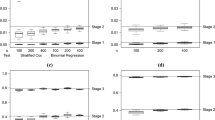Abstract
In the analysis of retrospective data or when interpreting results from a single-arm phase II clinical trial relative to historical data, it is often of interest to show plots summarizing time-to-event outcomes comparing treatment groups. If the groups being compared are imbalanced with respect to factors known to influence outcome, these plots can be misleading and seemingly incompatible with results obtained from a regression model that accounts for these imbalances. We consider ways in which covariate information can be used to obtain adjusted curves for time-to-event outcomes. We first review a common model-based method and then suggest another model-based approach that is not as reliant on model assumptions. Finally, an approach that is partially model free is suggested. Each method is applied to an example from hematopoietic cell transplantation.
Similar content being viewed by others
References
Breslow NE (1974) Covariance analysis of censored survival data. Biometrics 30: 89–9 doi:10.2307/2529620
Chang IM, Gelman R, Pagano M (1982) Corrected group prognostic curves and summary statistics. J Chronic Dis 35: 437–43 doi:10.1016/0021-9681(82)90019-4
Gail MH, Byar DP (1986) Variance calculations for direct adjusted survival curves, with applications to testing for no treatement effect. Biom J 28: 587–99 doi:10.1002/bimj.4710280508
Kalbfleisch JD, Prentice RL (1980) The statistical analysis of failure time data. John Wiley, New York
Makuch RW (1982) Adjusted survival curve estimation using covariates. J Chronic Dis 35: 437–43 doi:10.1016/0021-9681(82)90058-3
Sorror ML, Storer BE, Maloney DG, Sandmaier BM, Martin PJ, Storb R (2008) Outcomes after allogeneic hematopoietic cell transplantation with nonmyeloablative or myeloablative conditioning regimens for treatment of lymphoma and chronic lymphocytic leukemia. Blood 111: 446–52 doi:10.1182/blood-2007-07-098483
Zhang X, Loberiza FR, Klein JP, Zhang MJ (2007) A SAS macro for estimation of direct adjusted survival curves based on a stratified Cox regression model. Comput Methods Programs Biomed 88: 95–01doi:10.1016/j.cmpb.2007.07.010
Author information
Authors and Affiliations
Corresponding author
Rights and permissions
About this article
Cite this article
Storer, B.E., Gooley, T.A. & Jones, M.P. Adjusted estimates for time-to-event endpoints. Lifetime Data Anal 14, 484–495 (2008). https://doi.org/10.1007/s10985-008-9098-9
Received:
Accepted:
Published:
Issue Date:
DOI: https://doi.org/10.1007/s10985-008-9098-9




